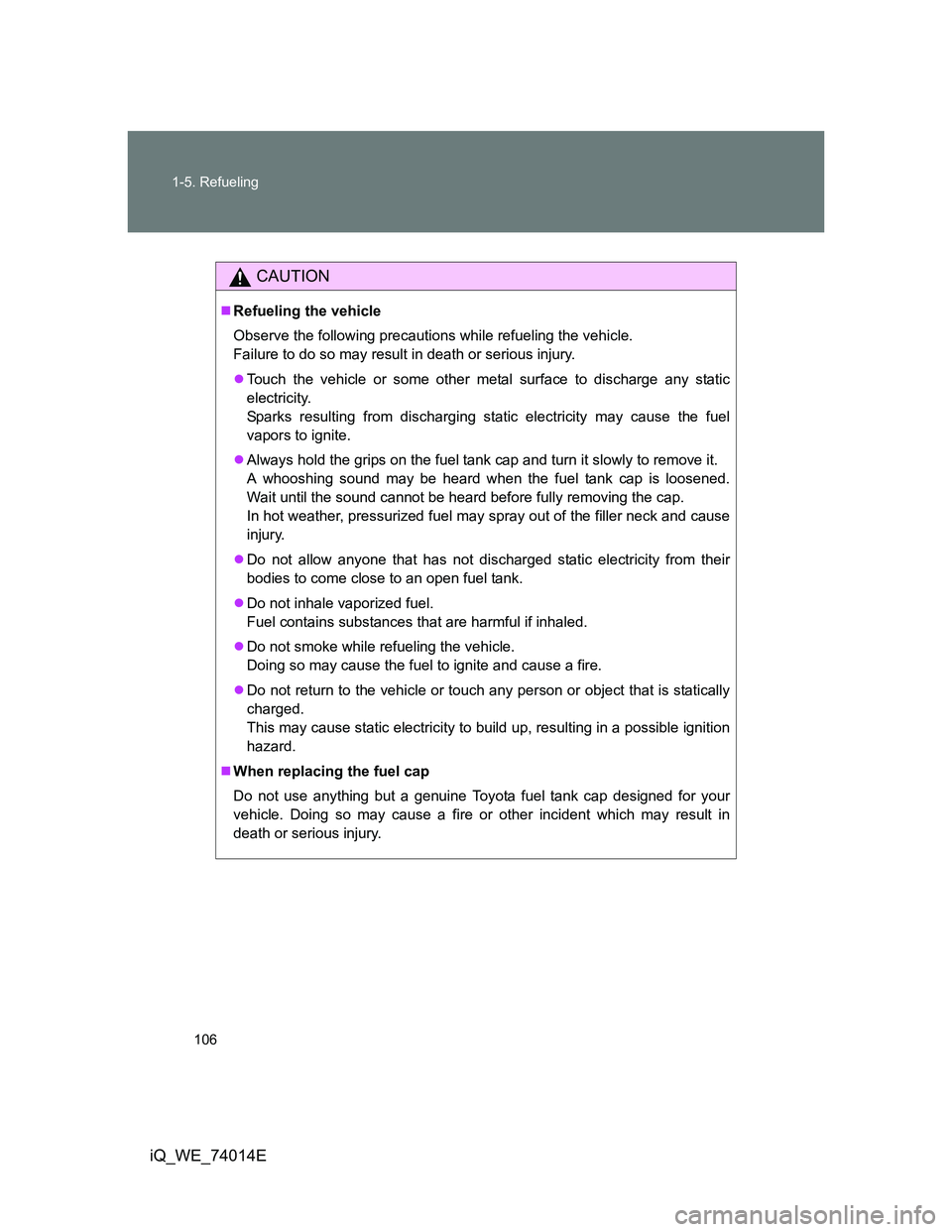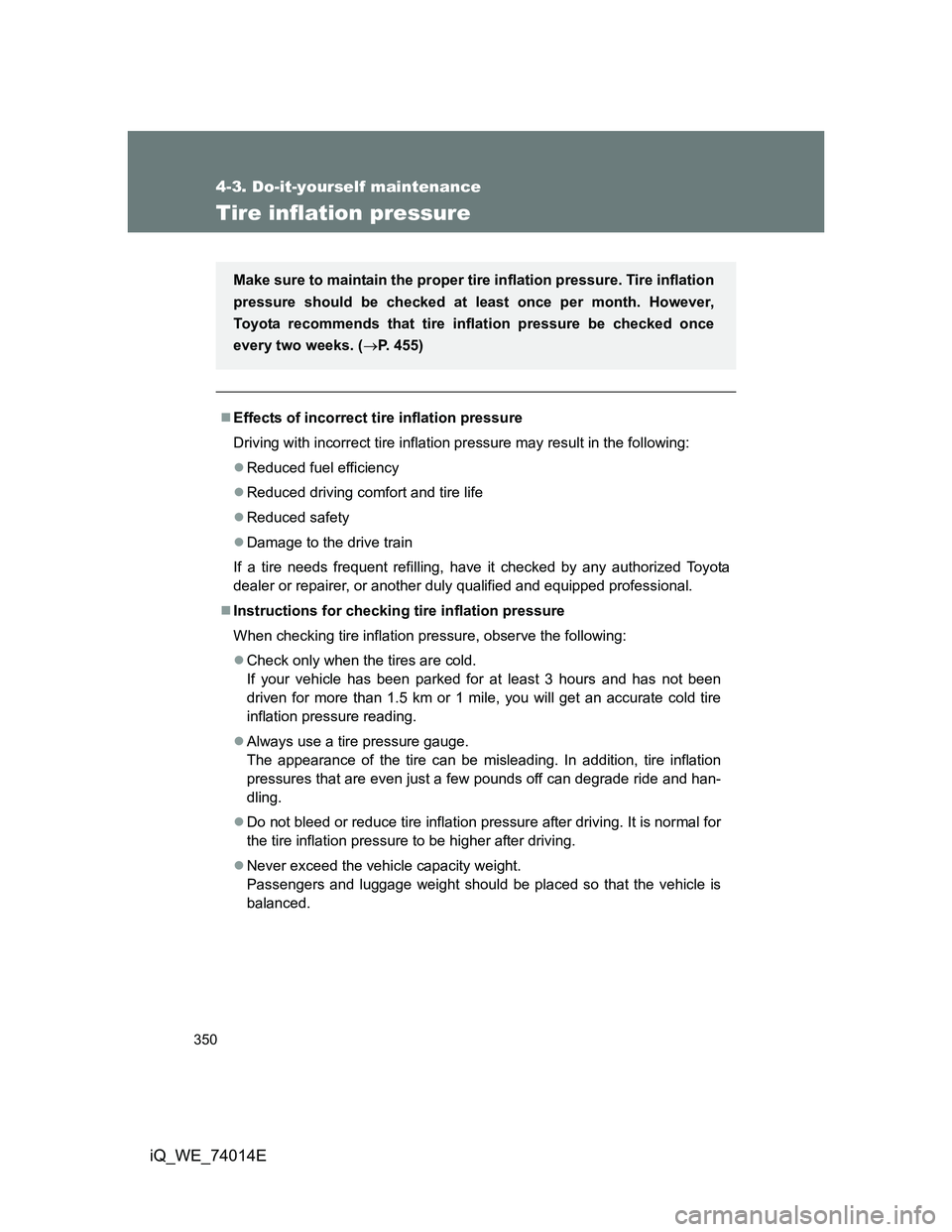Page 2 of 476

TABLE OF CONTENTSIndex
2
iQ_WE_74014E
1-1. Key information
Keys ...................................... 36
1-2. Opening, closing and locking
the doors
Smart entry & start system ... 39
Wireless remote control ........ 62
Side doors............................. 72
Back door.............................. 75
1-3. Adjustable components
(seats, mirrors, steering
wheel)
Front seats ............................ 79
Rear seats ............................ 82
Seat belts .............................. 86
Steering wheel ...................... 91
Anti-glare inside rear
view mirror .......................... 92
Outside rear view mirrors...... 95
1-4. Opening and closing
the windows
Power windows ................... 100
1-5. Refueling
Opening the fuel tank cap ... 103
1-6. Theft deterrent system
Engine immobilizer
system .............................. 108
Double locking system ........ 117
Alarm .................................. 1191-7. Safety information
Correct driving posture ....... 122
SRS airbags ....................... 124
Child restraint systems ....... 137
Installing child restraints ..... 148
Airbag manual on-off
system.............................. 159
2-1. Driving procedures
Driving the vehicle .............. 164
Engine (ignition) switch
(vehicles without smart
entry & start system) ........ 176
Engine (ignition) switch
(vehicles with smart
entry & start system) ........ 179
Multidrive ............................ 185
Manual transmission .......... 189
Turn signal lever................. 193
Parking brake ..................... 194
Horn ................................... 196
2-2. Instrument cluster
Gauges and meters............ 197
Indicators and warning
lights................................. 199
Multi-information display .... 205
1Before driving
2When driving
Page 35 of 476

1Before driving
35
iQ_WE_74014E
1-1. Key information
Keys.................................... 36
1-2. Opening, closing and locking
the doors
Smart entry & start
system .............................. 39
Wireless remote control ...... 62
Side doors .......................... 72
Back door ........................... 75
1-3. Adjustable components
(seats, mirrors, steering
wheel)
Front seats.......................... 79
Rear seats .......................... 82
Seat belts............................ 86
Steering wheel .................... 91
Anti-glare inside rear
view mirror ........................ 92
Outside rear view mirrors ... 95
1-4. Opening and closing
the windows
Power windows................. 1001-5. Refueling
Opening the fuel tank
cap .................................. 103
1-6. Theft deterrent system
Engine immobilizer
system ............................ 108
Double locking
system ............................ 117
Alarm ................................ 119
1-7. Safety information
Correct driving posture ..... 122
SRS airbags...................... 124
Child restraint systems ..... 137
Installing child restraints ... 148
Airbag manual on-off
system ............................ 159
Page 103 of 476
103
1
Before driving
iQ_WE_74014E
1-5. Refueling
Opening the fuel tank cap
Perform the following steps to open the fuel tank cap.
Before refueling the vehicle
Vehicles without smart entry & start system
Turn the engine switch off and ensure that all the doors and
windows are closed.
Vehicles with smart entry & start system
Turn the “ENGINE START STOP” switch OFF and ensure that
all the doors and windows are closed.
Opening the fuel tank cap
Pull up the fuel filler door
opener.
Page 104 of 476
104 1-5. Refueling
iQ_WE_74014E
Turn the fuel tank cap slowly
to open it.
Hang the fuel tank cap on the
back of the fuel filler door.
Page 105 of 476
105 1-5. Refueling
1
Before driving
iQ_WE_74014E
Closing the fuel tank cap
When replacing the fuel tank
cap, turn it until a clicking sound
is heard.
After releasing your hand, the cap
will turn slightly to the opposite
direction.
Fuel types
EU area:
Unleaded gasoline conforming to European standard EN228, Research
Octane Number of 95 or higher
Except EU area:
Unleaded gasoline, Research Octane Number of 95 or higher
Use of ethanol blended gasoline in a gasoline engine
Toyota allows the use of ethanol blended gasoline where the ethanol content
is up to 10%. Make sure that the ethanol blended gasoline to be used has a
Research Octane Number that follows the above.
Fuel tank capacity
Approximately 32 L (8.5 gal., 7.0 Imp. gal.)
Fuel gauge
When filled with less than 10 L per refueling, the fuel gauge may not display
accurately.
Page 106 of 476

106 1-5. Refueling
iQ_WE_74014E
CAUTION
Refueling the vehicle
Observe the following precautions while refueling the vehicle.
Failure to do so may result in death or serious injury.
Touch the vehicle or some other metal surface to discharge any static
electricity.
Sparks resulting from discharging static electricity may cause the fuel
vapors to ignite.
Always hold the grips on the fuel tank cap and turn it slowly to remove it.
A whooshing sound may be heard when the fuel tank cap is loosened.
Wait until the sound cannot be heard before fully removing the cap.
In hot weather, pressurized fuel may spray out of the filler neck and cause
injury.
Do not allow anyone that has not discharged static electricity from their
bodies to come close to an open fuel tank.
Do not inhale vaporized fuel.
Fuel contains substances that are harmful if inhaled.
Do not smoke while refueling the vehicle.
Doing so may cause the fuel to ignite and cause a fire.
Do not return to the vehicle or touch any person or object that is statically
charged.
This may cause static electricity to build up, resulting in a possible ignition
hazard.
When replacing the fuel cap
Do not use anything but a genuine Toyota fuel tank cap designed for your
vehicle. Doing so may cause a fire or other incident which may result in
death or serious injury.
Page 229 of 476

229
2
When driving
iQ_WE_74014E
2-5. Driving information
Cargo and luggage
CAUTION
Things that must not be carried in the luggage compartment
The following things may cause a fire if loaded in the luggage compartment.
Receptacles containing gasoline
Aerosol cans
Storage precautions
Observe the following precautions.
Failing to do so may result in death or serious injury.
Do not place cargo or luggage in or on the following locations as the item
may get under the brake or accelerator pedal and prevent the pedals from
being depressed properly, block the driver’s vision, or hit the driver or pas-
sengers, causing an accident.
• Driver’s feet
• Front passenger or rear seats (when stacking items)
• Instrument panel
• Dashboard
• Auxiliary box or tray that has no lid
Do not stack anything in the luggage compartment higher than the seat-
backs.
Such items may be thrown about and possibly injure people in the vehicle
during sudden braking or in an accident.
Take notice of the following information about storage precautions,
cargo capacity and load.
Stow cargo and luggage in the luggage compartment whenever
possible.
Be sure all items are secured in place.
Be careful to keep the vehicle level. Placing the weight as far for-
ward as possible helps maintain vehicle balance.
For better fuel economy, do not carry unnecessary weight.
Page 350 of 476

350
4-3. Do-it-yourself maintenance
iQ_WE_74014E
Tire inflation pressure
Effects of incorrect tire inflation pressure
Driving with incorrect tire inflation pressure may result in the following:
Reduced fuel efficiency
Reduced driving comfort and tire life
Reduced safety
Damage to the drive train
If a tire needs frequent refilling, have it checked by any authorized Toyota
dealer or repairer, or another duly qualified and equipped professional.
Instructions for checking tire inflation pressure
When checking tire inflation pressure, observe the following:
Check only when the tires are cold.
If your vehicle has been parked for at least 3 hours and has not been
driven for more than 1.5 km or 1 mile, you will get an accurate cold tire
inflation pressure reading.
Always use a tire pressure gauge.
The appearance of the tire can be misleading. In addition, tire inflation
pressures that are even just a few pounds off can degrade ride and han-
dling.
Do not bleed or reduce tire inflation pressure after driving. It is normal for
the tire inflation pressure to be higher after driving.
Never exceed the vehicle capacity weight.
Passengers and luggage weight should be placed so that the vehicle is
balanced.
Make sure to maintain the proper tire inflation pressure. Tire inflation
pressure should be checked at least once per month. However,
Toyota recommends that tire inflation pressure be checked once
every two weeks. (P. 455)